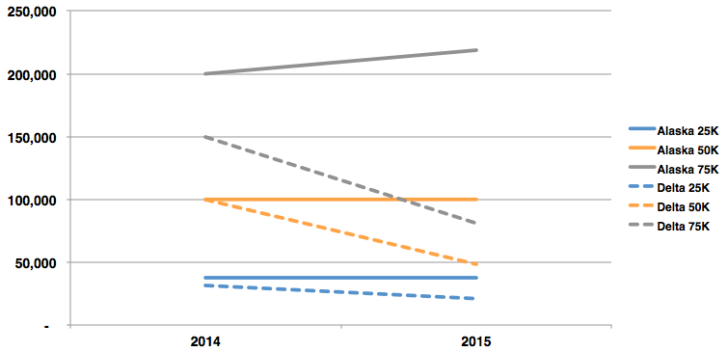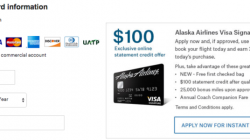Alaska Airlines announced today several tweaks to its Mileage Plan loyalty program. These include a higher tier bonus for their top elite members (MVP Gold 75K), new and higher fare class multipliers for some of their more expensive tickets, and a modified earnings table that applies when flying on their partner, Delta Air Lines.
I interpret these changes as a commitment to retaining their current distance-based earning method, though I have no knowledge of their long-term plans. It may come as a relief to some people on Flyertalk who were worrying about survey questions that talked about revenue-based changes. Other carriers like Delta and United Airlines have already committed to revenue-based programs that use the price of the ticket to determine your elite status and the number of award miles you earn.
New Tables for Earning Alaska Miles on Delta Flights
It figures that there would be changes to the earnings table for Delta. The historical pattern among U.S. carriers was to award a 50% bonus for more expensive refundable or premium cabin fares. But when United and Delta begins awarding miles based on revenue in 2015, a first class ticket could easily earn 10X or more miles than a heavily discounted economy class fare. Delta SkyMiles is one of Mileage Plan’s partners, so how do you bridge that gap when you could credit the same flight to either program?
Alaska negotiated a compromise by continuing to award miles based on distance, but the fare class multipliers will change. The most expensive first class tickets will earn 200% of the distance flown, while the cheapest will earn just 25 to 50%. (It does depend on who markets the fare. Alaska has many fewer fare classes than Delta and less variation between them. So pay attention to which airline you book with, what flight number is on the ticket, and who you credit to.) I’ve outlined these changes in more detail in a blog post I wrote for Alaska’s company blog.
New 125% Tier Bonus for MVP Gold 75K
At the same time, Alaska took this opportunity to introduce some changes when flying on its own planes. The most simple change is an increased 125% bonus on award miles for top-tier MVP Gold 75K members. These are customers who fly 75,000 miles a year on Alaska only, or 90,000 miles a year with Alaska and its partners. Previously these members earned only a 100% bonus — the same as MVP Gold.
MVP Gold 75K members will also continue to earn a lump sum bonus of 50,000 miles each year that they qualify. This can make the program extremely lucrative. Consider that if someone is flying 75,000 miles and getting a 125% bonus plus an extra 50,000 miles that works out to 218,750 miles.
Most carriers only offer a 75% or 100% bonus to their members who fly 75,000 miles. Delta currently offers a 125% bonus to its Diamond Medallion members who fly 125,000 miles, but this is changing next year when new revenue-based earning rules go into effect. Next year, Diamond Medallion members will earn 11 miles per dollar while general members (no status) will earn 5 miles per dollar — a difference of 120%. That means Diamond Medallion members will actually see a decrease in their effective tier bonus.
As far as I can tell, Alaska will have the highest tier bonus of any U.S. carrier in 2015.
You Can Earn a LOT More Miles with Alaska Next Year
To my Seattle and Portland readers who ask if they should fly Alaska or Delta, the graph below shows how things are changing between 2014 and 2015. Alaska was already pretty competitive. I wonder if it even needed to offer more miles to its top members. The differences between the two programs will be difficult to ignore next year.

Platinum Medallion members (who fly 75,000 miles in a year) have a 100% tier bonus in 2014 and can earn 150,000 miles. But next year they’ll earn 9 miles per dollar spent. Minimum revenue requirements for elite status mean they’ll also have to spend at least $9,000. That works out to just 81,000 award miles.
Some people might retort: Well, I actually buy expensive premium cabin or last-minute fares. I’ll spend much more than $9,000 and so I’ll earn more than “just” 81,000 miles on Delta. But a more flexible fare on Delta still earns at the same rate of 9 miles/dollar. There are no more fare class bonuses, so you may not earn that much more.
Alaska will still have fare class bonuses. In fact, they’re increasing them! If you’re buying some last-minute fares you could get 25% to 75% more miles in addition to whatever tier bonus you earn. So those big spenders may earn much more that my estimates suggest.
| Fare Class | Current Bonus | Bonus in 2015 |
|---|---|---|
| F (first class) | 50% | 75% |
| P (discounted first class) | 50% | 50% |
| Y (full-fare economy class) | 25% | 50% |
| S | 0% | 50% |
| B | 0% | 25% |
| M | 0% | 25% |
Overall I think this is great news. There is a potential downside that issuing so many miles could lead to devaluations in the award charts. Alaska has not made major changes to these for a while and only issued a few minor increases (and some decreases!) earlier this year. But for now, with some very flexible award rules and generous award prices, I can think of tons to do with all these extra miles.

